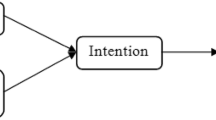Abstract
The concept of recreational shopper identity, a dimension of the consumer—s self-concept, is contrasted with simple shopping enjoyment, which has characterized most past research on recreational shopping. Two survey studies investigate recreational shopper identity in a clothing shopping context. In Study 1, the Recreational Shopper Identity (RSI) Scale is validated with a sample of 561 adult consumers, demonstrating that recreational shopping is experienced as a true leisure activity. In Study 2, involving 354 adult consumers, the RSI Scale is used to identify three groups of shoppers who differ in the degree to which they incorporate recreational shopping into their self-concepts. Recreational shopping enthusiasts are found to engage more extensively in a range of retail shopping behaviors, to spend more money shopping (i.e., they are not just browsers), and are more “multi-channel” than other shoppers, reporting higher levels of Internet, catalog, and TV home shopping as well as traditional “brick-and-mortar” shopping.
Similar content being viewed by others
References
Anderson, James C. and David W. Gerbing. 1988. “Structural Equation Modeling in Practice: A Review and Recommended Two-Step Approach.”Psychological Bulletin 103 (3): 411–423.
Arnold, Mark J. and Kristy E. Reynolds. 2003. “Hedonic Shopping Motivations.”Journal of Retailing 77:77–95.
Babin, Barry J., William R. Darden, and Mitch Griffin. 1994. “Work and/ or Fun: Measuring Hedonic and Utilitarian Shopping Value.”Journal of Consumer Research 20 (March): 644–656.
Belk, Russell W. 1988. “Possessions and the Extended Self.”Journal of Consumer Research 15 (September): 139–168.
Bellenger, Danny N. and Pradeep K. Korgaonkar. 1980. “Profiling the Recreational Shopper.”Journal of Retailing 56 (Fall): 77–92.
Berlyne, Daniel E. 1969. “Laughter, Humor and Play.” InHandbook of Social Psychology, 2d ed., Vol. 3. Eds. Gardner Lindzey and Elliott Aronson. Reading, MA: Addison-Wesley, 795–852.
Bloch, Peter H, 1986. “Product Enthusiasm: Many Questions, a Few Answers.” InAdvances in Consumer Research, Vol. 13. Ed. Richard J. Lutz. Provo, UT: Association for Consumer Research, 539–543.
—, Nancy M. Ridgway, and Scott A. Dawson. 1994. “The Shopping Mall as Consumer Habitat.”Journal of Retailing 70 (1): 23–42.
Campbell, Colin. 1997a. “Recreational Shopping as the Context of Desire.” InSosiologisk Arbok, Vol. 2. Eds. Susann Solli, Arild Thomassen, and Per Otnes. Oslo: Novus, 81–104.
—. 1997b. “Shopping, Pleasure and the Sex War.” InThe Shopping Experience. Eds. Pasi Falk and Colin Campbell. London: Sage, 166–176.
Celsi, Richard L., Randall L. Rose, and Thomas W. Leigh. 1993. “An Exploration of High-Risk Leisure Consumption Through Skydiving.”Journal of Consumer Research 20 (June): 1–23.
Csikszentmihalyi, Mihaly. 1975.Beyond Boredom and Anxiety. San Francisco: Jossey-Bass.
Faber, Ronald J. and Thomas C. O’Guinn. 1992. “A Clinical Screener for Compulsive Buying.”Journal of Consumer Research 19 (December): 459–469.
Falk, Pasi and Colin Campbell. 1997. “Introduction.” InThe Shopping Experience. Eds. Pasi Falk and Colin Campbell. London: Sage, 1–14.
Fischer, Eileen and Brenda Gainer. 1991. “I Shop Therefore I Am: The Role of Shopping in the Social Construction of Women’s Identities.” InProceedings of the Conference on Gender and Consumer Behavior, Vol. 1. Salt Lake City, UT: Association for Consumer Research, 350–357.
Gerbing, David W. and James C. Anderson. 1988. “An Updated Paradigm for Scale Development Incorporating Unidimensionality and Its Assessment.”Journal of Marketing Research 25 (May): 186–192.
Haggard, Lois M. and Daniel R. Williams. 1992. “Identity Affirmation Through Leisure Activities: Leisure Symbols of the Self.”Journal of Leisure Research 24 (1): 1–18.
Lunt, Peter and Sonia M. Livingstone. 1992.Mass Consumption and Personal Identity. Philadelphia: University Press.
Mathwick, Charla, Naresh Malhotra, and Edward Rigdon. 2001. “Experiential Value: Conceptualization, Measurement and Application in the Catalog and Internet Shopping Environment.”Journal of Retailing 77 (1): 39–56.
Miller, Daniel, Peter Jackson, Nigel Thrift, Beverly Holbrook, and Michael Rowlands 1998.Shopping, Place and Identity. London: Routledge.
Prus, Robert and Lome Dawson. 1991. “Shop’til You Drop: Shopping as Recreational and Laborious Activity.”Canadian Journal of Sociology 16 (Spring): 145–164.
QVC. 2003.Get to Know Us: A Brief Backgrounder for Brands Considering Televised Retail. West Chester, PA: QVC.
Richins, Marsha L. and Scott Dawson. 1992. “A Consumer Values Orientation for Materialism and Its Measurement: Scale Development and Validation.”Journal of Consumer Research 19 (December): 303–316.
Shamir, Boas. 1992. “Some Correlates of Leisure Identity Salience: Three Exploratory Studies.”Journal of Leisure Research 24 (4): 301–323.
Stebbins, Robert A. 1982. “Serious Leisure: A Conceptual Statement.”Pacific Sociological Review 25 (2): 251–271.
Tatzel, Miriam. 1991. “On Not Liking to Shop for Clothes.” InProceedings of the Society for Consumer Psychology. Eds. Michael Lynn and Jeffrey M. Jackson. Washington, DC: Society for Consumer Psychology (Division 23), American Psychological Association, 46–53.
Unger, Lynette S. and Jerome B. Kernan. 1983. “On the Meaning of Leisure: An Investigation of Some Determinants of the Subjective Experience.”Journal of Consumer Research 9 (March): 381–392.
Westbrook, Robert A. and William C. Black. 1985. “A Motivation-Based Shopper Typology.”Journal of Retailing 61 (Spring): 78–103.
Author information
Authors and Affiliations
Additional information
Michael Guiry (guirym@newpaltz.edu) is an assistant professor of marketing in the School of Business at the State University of New York, New Paltz. He received his Ph.D. from the University of Florida. His research interests include recreational shopping and cross-cultural consumer behavior.
Anne W. Mägi (anne.magi@cba.ufl.edu) (Ph.D., Stockholm School of Economics) is a visiting scholar in the University of Florida Marketing Department. Her research interests include retail patronage, consumer loyalty, price perceptions and knowledge, and impulsive shopping behavior. Her research has been published in theJournal of Retailing and theJournal of Retailing and Consumer Services.
Richard J. Lutz (richard.lutz@cba.ufl.edu) is the J. C. Penney Professor of Marketing in the Warrington College of Business Administration at the University of Florida. He received his Ph.D. from the University of Illinois, Urbana-Champaign. His research lies in the area of consumer behavior and in particular consumer response to advertising. His work has appeared in theJournal of Marketing, theJournal of Marketing Research, theJournal of Consumer Research, and theJournal of Advertising.
Rights and permissions
About this article
Cite this article
Guiry, M., Mägi, A.W. & Lutz, R.J. Defining and measuring recreational shopper identity. J. of the Acad. Mark. Sci. 34, 74–83 (2006). https://doi.org/10.1177/0092070305282042
Issue Date:
DOI: https://doi.org/10.1177/0092070305282042




